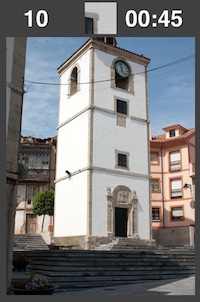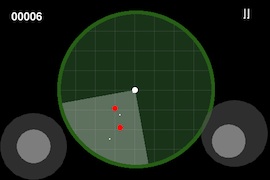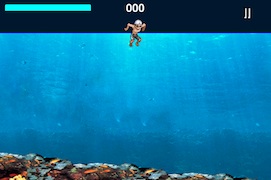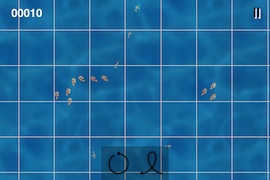You’re not alone, I was also doing prototyping wrong until a few years ago. There are probably many different ways of prototyping games correctly, and maybe your way works great for you. In that case, a more accurate title for this post could have been “Prototyping: I Was Doing It Wrong”.
A good game prototype is something fast/cheap that allows you to answer a specific question about your game. The key points there are fast/cheap and specific question. It’s not a level of a game, it’s not a “vertical slice”, and it’s certainly not an engine for the game.
Chris Hecker and Chaim Gingold gave one of the best presentations on the subject of rapid prototyping. It was hugely influential for me, and it made me re-think the way I do prototypes. If you get a chance, find the audio for the presentation, it’s definitely worth it.
MISTAKE #1: GOING WITH THE FIRST IDEA
 Every company I’ve ever worked at has done this mistake. The team hashes out a bunch of ideas, and somehow they pick one (or create it by committee). Maybe they’ll create a prototype to show something about the game, or maybe they’ll dive straight and start writing a design document and developing technology. If you’re lucky, or you have an extremely talented game director, the game that comes out of the other end might be fantastic. In most cases, it’s just a so-so idea and the team only realizes it when the first level comes together, years later, at around alpha time. At this point the choice is canning a project after spending millions of dollars, or patching it up to try to salvage something. Neither idea is particularly appealing.
Every company I’ve ever worked at has done this mistake. The team hashes out a bunch of ideas, and somehow they pick one (or create it by committee). Maybe they’ll create a prototype to show something about the game, or maybe they’ll dive straight and start writing a design document and developing technology. If you’re lucky, or you have an extremely talented game director, the game that comes out of the other end might be fantastic. In most cases, it’s just a so-so idea and the team only realizes it when the first level comes together, years later, at around alpha time. At this point the choice is canning a project after spending millions of dollars, or patching it up to try to salvage something. Neither idea is particularly appealing.
Creating a prototype for a game you know you’ve already committed to is pointless. It’s nothing more than an exercise to keep management happy. Frankly, I even made that same mistake at Power of Two, whenwe prototyped the game idea we had in mind and immediately moved on into pre-production (and yes, later we realized we had to change things to make it more interesting).
What I do now is to force myself to prototype several of my top ideas before committing to any one project. I have a page (actually, a wiki page) with every game idea or thought I have. That page has way over a hundred entries, and every so often I cull and reorganize it, bringing up the most promising ideas towards the top. Whenever I’m in prototyping mode, I start grabbing them from the top and prototype them.
 With a good prototype it’s easy to see if an idea is worthwhile. If it’s not, I discard it and move on to the next one. If it has potential but it’s just so-so, I either choose to continue just a bit longer (to ask another, better question) or I shelve it back in the list of potential game ideas. Maybe at some later time, things might click in or I might have a new inspiration and the game idea might become a lot stronger.
With a good prototype it’s easy to see if an idea is worthwhile. If it’s not, I discard it and move on to the next one. If it has potential but it’s just so-so, I either choose to continue just a bit longer (to ask another, better question) or I shelve it back in the list of potential game ideas. Maybe at some later time, things might click in or I might have a new inspiration and the game idea might become a lot stronger.
Also, often times, after doing one prototype and deciding against it, a new idea will come up. Usually a variation on the original prototype or something directly sparked from it, so I’ll find myself jumping to that idea instead of one of the ones I had saved in my list.
Eventually, one idea will click and you’ll know that’s “the one”. If you’re lucky (or unlucky) enough to have that happen with the first one you try, I still recommend doing a few more prototypes. If nothing else, you might be prototyping future projects, so it’s certainly not wasted time. For my current project, I went through eight prototypes before finding “the one” (several of them were a collaboration with Miguel). Eight to ten prototypes per project is roughly what I’m hearing from other indies with this approach.
MISTAKE #2: NOT HAVING A GOOD QUESTION
A good prototype attempts to answer a question about the game. But not all questions are created equal. First of all, a question needs to be relevant and crucial to the project. “Can I have a pretty settings screen?” isn’t a particularly difficult question to answer, so it doesn’t deserve its own prototype. “Can I control little planes by drawing smooth lines on the screen?” is a much bigger unknown (before Flight Control anyway, today you can just download the game and immediately answer yes).
 Also, a good question is concise and can be answered in a fairly unambiguous way. “Is this game awesome?” isn’t a good question because “awesome” is very vague. A better question might be “Can I come up with a tilt control scheme that is responsive and feels good?”. Feels good is a very subjective question, but it’s concrete enough that people can answer that pretty easily after playing your prototype for a bit.
Also, a good question is concise and can be answered in a fairly unambiguous way. “Is this game awesome?” isn’t a good question because “awesome” is very vague. A better question might be “Can I come up with a tilt control scheme that is responsive and feels good?”. Feels good is a very subjective question, but it’s concrete enough that people can answer that pretty easily after playing your prototype for a bit.
Even though most questions are about game design, they can also be about any other aspect of the game. Maybe you’re doing something tricky with technology and you want to make sure it’s feasible. If not, there’s no point in even starting. It’s more uncommon to think of prototyping art, but it’s also a very valid approach: “Will this art style allow foreground objects to stand out enough?” “Will the lighting approach allow the player to see important features in enough detail?”. Often you can do these art “prototypes” directly in Photoshop or a 3D modeling package.
In the case of Flower Garden, the main unknown was the technology behind the procedural flowers. So I created a prototype to answer the question “Can I create compelling procedural flowers that grow in real-time and the user can interact with them?”. The prototype had several parts to answer that question: the geometry generation, the animation, the simulation, and the rendering. There isn’t anything else particularly ground-breaking in the rest of the Flower Garden code, so as soon as I was able to answer “yes” to that question, I green-lighted the project and started production on it.
For larger projects, you might have several major, outstanding questions, so you’ll need to do multiple prototypes. Unless they’re very closely related, I find it easier to keep them separate instead of building on top of the same prototype.
Without a good question, it’s too easy for a prototype to go on for a long time. You feel you’re making progress because new things are added, but you have no real sense of when to stop or when it’s done. You really have to focus on the question, ignore everything else, and be merciless in your approach.
MISTAKE #3: TAKING TOO LONG
 One of the key concepts in the definition of a prototype was that it has to be fast/cheap (which are two sides of the same coin). What’s fast enough? It depends on the length of the project itself. It’s not the same thing to do a prototype for a two-month iPhone game, than for a three-year console game. Also, a larger, more expensive project probably has more complex questions to answer with a prototype than a simple iPhone game.
One of the key concepts in the definition of a prototype was that it has to be fast/cheap (which are two sides of the same coin). What’s fast enough? It depends on the length of the project itself. It’s not the same thing to do a prototype for a two-month iPhone game, than for a three-year console game. Also, a larger, more expensive project probably has more complex questions to answer with a prototype than a simple iPhone game.
In my case, I shoot for one-day prototypes. If you already have the tech to create games with, one day allows you to focus 100% on answering the question. By the end of the day, or even before, I have a pretty good idea how the game is going to work out. My shortest prototype ever was a 2-hour one. I thought it was going to be longer, but I managed to complete everything to answer the question in two hours (for the record, I didn’t can that idea, but I shelved it for a possible future project).
Game jams are a great way to get over the mental block of doing quick prototypes. There you are focused on making the game on a very short time, surrounded by people trying to do the same thing. I can’t think of a more fun way to prototype than that!
Also, think beyond programming. Is there a faster way you can answer the prototype question? Maybe you can use the modding capabilities of an existing game, or even do a mockup with paper moving pieces around. Don’t fall in the trap of thinking you have to code a prototype if something simpler and faster will do.
If you find that a day is not enough, take a step back and really ask yourself why you need more time. Were you getting side-tracked on things that were irrelevant to the prototype (menus, tech, art, etc)? Are you asking a question that the prototype can’t answer? Do you have the game idea clearly defined in your head?
MISTAKE #4: BUILDING A SYSTEM, NOT A GAME
 When you’re making a prototype, if you ever find yourself working on something that isn’t directly moving your forward, stop right there. As programmers, we have a tendency to try to generalize our code, and make it elegant and be able to handle every situation. We find that an itch terribly hard not scratch, but we need to learn how. It took me many years to realize that it’s not about the code, it’s about the game you ship in the end.
When you’re making a prototype, if you ever find yourself working on something that isn’t directly moving your forward, stop right there. As programmers, we have a tendency to try to generalize our code, and make it elegant and be able to handle every situation. We find that an itch terribly hard not scratch, but we need to learn how. It took me many years to realize that it’s not about the code, it’s about the game you ship in the end.
Don’t write an elegant game component system, skip the editor completely and hardwire the state in code, avoid the data-driven, self-parsing, XML craziness, and just code the damned thing.
When you’re prototyping, it’s a race to answer the main prototype question. Everything is expendable. Don’t even worry about memory leaks, hardwired numbers, or how you load resources. Just get stuff on the screen as quickly as you can.
And don’t ever, ever, use the argument “if we take some extra time and do this the right way, we can reuse it in the game”. EVER.
























 1009
1009

 被折叠的 条评论
为什么被折叠?
被折叠的 条评论
为什么被折叠?








